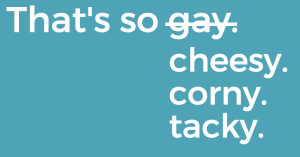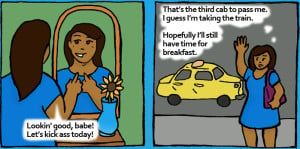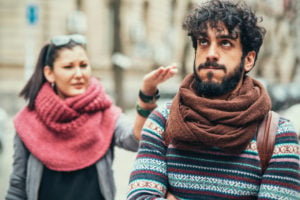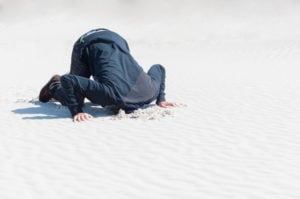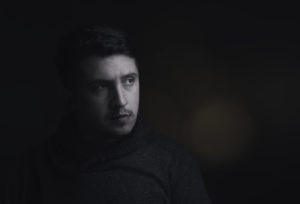
Person looking dejected in the dark.
Michelle Zenarosa contributed reporting.
TW: racism, violence, murder
I was 6 years old when 9/11 happened.
I don’t remember a lot. I don’t remember what the news was reporting. I don’t even remember how or if my parents tried to explain it to me. The only thing I seem to remember was a conversation I witnessed between my mother and my older brother in the kitchen of our unassuming suburban home.
My mother asked my brother to go to the Persian grocery store for some ingredients. She handed him the money and the list, as she always did. But then — unlike every other time she’d sent him on an errand — she put her hand on his arm and said, “Be careful.”
Even I felt heavy witnessing her warning. I didn’t understand why she was telling my brother to be careful in our suburban town, just 50 miles outside of Los Angeles. After all, it had been rated the safest town in the state several years in a row.
Still, something inside me just knew that these two events — my 16-year-old brother getting a stern warning before going to pick up groceries and the attacks on 9/11 — were somehow connected.
That memory stayed with me for years, but it wasn’t until my high school U.S. History class skimmed over “current events” that something suddenly clicked. My mother was telling my brother to be careful because she knew our “safe” suburban town was primarily white and conservative.
She was telling him to be careful because we’re Iranian-American and after former President George W. Bush announced that Iran was part of the “Axis of Evil” in the War on Terror, our family — and my teenage brother in particular — could now potentially be labeled by neighbors as terrorists.
The Merriam-Webster dictionary defines terrorism as “the systematic use of terror especially as a means of coercion.”
Nowhere does it explicitly say “Islamic extremist,” but since 9/11, fueled by media and government propaganda, anyone who can be perceived as a Middle-Eastern Muslim (basically anyone who looks like my brother) can be pegged as a terrorist.
This American terrorist narrative that’s insidiously floating around, however, doesn’t stem from real facts.
In reality, since 9/11, white men committing acts of violent extremism have been responsible for 73% of the deaths caused in these types of incidents within the United States. That’s nearly 3 out of 4 times.
Meanwhile, radical Islamist extremists were responsible for only 27 percent, or roughly 1 out of 4 incidents.
The difference in these numbers is astonishing. Still, white mass murderers very rarely are labeled “terrorists,” by the media or the government, though their actions clearly fit the bill.
Just last week in Las Vegas, a mass shooting that killed at least 58 people dethroned the mass shooting at Pulse nightclub (which happened just last June) as the deadliest mass shooting in all of modern US history.
Terror spreads as mass shootings become the new norm. Many people feel afraid to enjoy events in public settings — movie theaters, nightclubs, schools, music festivals.
So why has nothing changed if we, as a country, are ostensibly committed to combatting terrorism?
We have policies that address Islamic extremist terrorism, like a Muslim ban, which mostly banned travel from countries with large Muslim populations, and increased “random” screenings and airport detainments.
Our current administration has even discussed bringing back a once-failed Muslim registry, which effectively deported over 13,000 people from 2001 to 2003 but did not help catch a single terrorist.
Meanwhile, the only policy solution for white terrorism that gets discussed is gun control — a highly controversial but ever-present topic that never seems to get any real traction.
The reality is that these tragic events are going to continue to happen until we are able to call a spade a spade. We need to call these mass shooters terrorists.
But even more importantly, we need to face these 3 truths about ourselves and the way our society functions to truly stop them from recurring again and again:
1. Toxic Masculinity
America has had a long love affair with guns. Marry that with toxic masculinity — society’s traditional expectations of how manhood should look — and the combination has proven to be deadly.
Toxic masculinity, which is grounded in sexual aggressiveness, stoicism, violence, and misogyny, has directly resulted in increasingly frequent mass shootings by disturbed (mostly white) men, who bring loaded firearms into schools, movie theaters, and churches.
In the media, these white terrorists are labeled “mentally ill” and “lone wolves.” They are painted to be outsiders who can’t keep a job, a girlfriend, or even a group of good friends, and become anxious or depressed as a result.
These facts cause society to see them as “losers,” and, in all likelihood, white terrorists come to see themselves in the same way. But their desire to prove otherwise causes them to lash out.
Thanks to toxic masculinity, most men are taught at a young age to admire physical strength, logic, and power. As a result, many of them look to physical violence, the ultimate signifier of manliness, as a means of gaining power and control.
The problem is that blaming mass shootings on mental illness only creates more stigma around mental illness, painting it as a danger to neurotypical people over those actually facing psychological problems.
In truth, it’s toxic masculinity that fuels many men to subsequently act out in abusive ways. It’s no coincidence that 40% of domestic terrorists begin mass shootings by murdering their a partner or ex-partner.
The mental illness excuse turns a blind eye to the destructive issue the United States has with socially constructed gender stereotypes (It’s worth noting that rates of psychiatric disorders are almost the same between genders, and yet mass shootings are almost exclusively committed by men).
By regarding white terrorism simply as the actions of the mentally ill, we continue to ignore the connections to toxic masculinity.
2. White Supremacy
Since the events at Charlottesville, Virginia, there’s been more conversation about white supremacy, with people on social media advocating to “punch a Nazi,” or sharing videos of white men with swastikas getting knocked out in public.
White supremacy is much deeper — and less obvious — than swastikas, white hoods, and the overt verbal or physical violence waged against marginalized communities by white men.
When we as a society talk about white supremacy only in its most explicit iterations, we lose sight of how racism continues to operate — systemically and in the day-to-day.
It’s no secret that our roots in white supremacy run deep — all the way from the nation’s founding with the raping and pillaging of indigenous people and the proliferation of the Transatlantic slave trade. The horrible actions of white people with power have incurred generational trauma that is still present today.
White supremacy looks like white people being the default characters and heroes in my books and on my TV screen. It looks like like the devaluation of black lives.
It also looks like the mass incarceration of people of color, namely black and brown men. It looks like high rates of poverty, substance abuse, and suicides among Native Americans.
It looks like the microaggressions I face — at a new job or at a bar — when I’m asked for my name in a conversation and the other person immediately asks me “where I’m from,” or “what I am.”
It’s these types of everyday realities that fuel white supremacy and anchor mass shootings perpetrated by white men, which happen, on average, once a day and have increased over the last decade.
It’s no coincidence, either, that there has been a rise in hate crimes since Trump was elected, and if recent events at Charlottesville and elsewhere are any indication, emboldened white terrorism will only get worse under Trump.
Another part of the problem is that the media continues using terms like “white nationalists,” “neo-Nazis,” and the “alt-right” instead of terrorists.
While these labels are all apt descriptors of their socio-political views and thereby their motives, they’re lacking when it comes to describing white supremacists’ actions.
3. Capitalism
After this past presidential election, everyone blamed working-class white people living in rural America for Trump’s win. When the numbers came out that white people across class status voted for him, some people were shocked. Many of us on the left were not.
While poor white people weren’t the only ones responsible for putting Trump in the White House, there is something to be said about how some poor white men are driven to violence and mass shootings in our capitalist society.
On one hand, there’s living in a white supremacist society, which gives white male shooters the privilege of not being labeled a terrorist. On the other hand, there’s living in a capitalist society that pushes men towards violence.
Capitalism’s hyper-competitive individualism has successfully isolated Americans, eroded the family unit, and made it increasingly difficult to build community and hold trust and give support to our neighbors.
There’s a loneliness that intensifies violent outbursts in these white terrorists that we cannot ignore. And that’s a direct result of living in a capitalist society.
***
My Iranian-American brother could have been targeted due to a half-baked stereotype about Middle Eastern men and Islamic extremism after 9/11. But many South Asian men are targeted due to this stereotype — their complexions, turbans, and beards misconceived as the characteristics of an Islamic extremist.
In one astonishing incident back in February, Adam Purinton killed one Indian man and injured another in a restaurant, claiming he had killed “two Iranians.”
People of color that are perceived as Middle Eastern or Muslim face ghastly consequences at the hands of ignorant white terrorists. Meanwhile, white men are never pointed at and assumed to be mass murderers, despite the fact that they make up 31% of the population and are responsible for 63% of mass shootings.
If American people are truly worried about terrorism and the safety of their country and people, then we need to shift our focus onto white terrorists, as they increasingly seem to be the real threat.
We must fight against white terrorism with the same fervor our government fights against foreign terrorism, through stronger gun control and anti-discrimination legislation, and by addressing these three ugly truths about our country.
And maybe, in the process, we’ll uncouple the word “terrorism” from the exclusive image of the Middle Eastern Muslim man that, currently, remains stubbornly lodged in our heads.
[do_widget id=’text-101′]
Nahal Amouzadeh is a reporting fellow for Everyday Feminism. She has two B.A. degrees from UCLA in English and Gender Studies. She is a writer, poet, second-generation Iranian-American, self-identified postcolonial feminist, and cat lady. Her twitter is @nahalll.
Search our 3000+ articles!
Read our articles about:
Our online racial justice training
Used by hundreds of universities, non-profits, and businesses.
Click to learn more
Most Read Articles
- « Previous
- 1
- …
- 30
- 31
- 32








